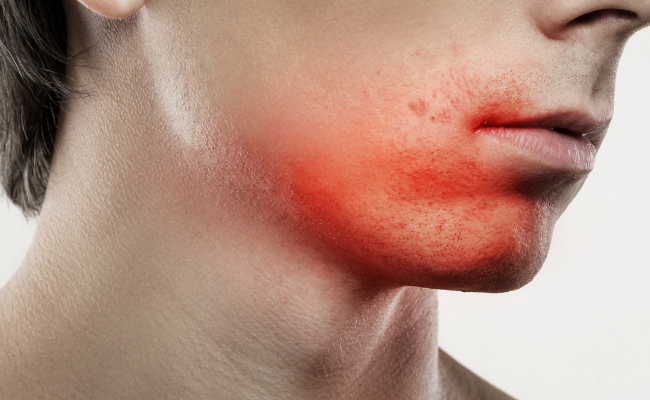How to Treat Razor Bumps?
- November 16, 2023
- No Comments

What are Razor Bumps?
Razor bumps, scientifically termed pseudofolliculitis barbae, are a prevalent skin condition that often arises post-shaving. Characterized by red, inflamed, and occasionally itchy skin areas, these bumps stem from an unfortunate interplay between shaved hair and hair follicles. Rather than growing outward, the cut hair curls back into the skin, prompting irritation and inflammation. While individuals with curly hair are more prone to razor bumps due to the natural curling tendency of their hair, this concern is widespread, particularly in regions where routine shaving is integral to grooming practices.
Despite the discomfort razor bumps may cause, effective measures exist to alleviate irritation. Employing aloe vera or embracing gentle exfoliation can bring relief. Incorporating preventive strategies, such as shaving in the direction of hair growth and utilizing an electric razor, plays a crucial role in minimizing the occurrence of razor bumps.
Why Do Razor Bumps Occur?
Understanding the root causes of razor bumps is crucial in developing effective treatment and prevention strategies. The primary culprit behind razor bumps is improper shaving techniques. When hair is cut too closely or below the skin's surface, it has a higher likelihood of curving back into the follicle, triggering irritation. Individuals with curly hair face an increased risk of razor bumps due to the inherent curling nature of their hair. Additionally, the use of dull razors, shaving too closely, or neglecting to adequately lubricate the skin can contribute to the development of razor bumps.
How Do Razor Bumps Develop?
The genesis of razor bumps is closely tied to the act of shaving. Shortly after shaving, small, red bumps begin to appear around the shaved area, signaling the onset of this common skin issue. As the shaved hair regrows, it may take a curved trajectory back into the skin, causing inflammation and giving rise to raised, itchy bumps. In some cases, razor bumps can escalate and become infected, leading to the formation of pustules or more severe skin irritation.
Treatment Solutions for Razor Bumps
- Warm Compress: Applying a warm compress to the affected area can work wonders in soothing inflammation and opening up the pores. This, in turn, facilitates the release of ingrown hairs and reduces the discomfort associated with razor bumps.
- Exfoliation: Regular exfoliation is a key strategy in the fight against razor bumps. By removing dead skin cells, exfoliation helps unclog hair follicles, diminishing the likelihood of hairs becoming trapped and causing irritation.
- Salicylic Acid: Products containing salicylic acid are often effective in treating razor bumps. Salicylic acid serves as an exfoliant, promoting the shedding of dead skin cells and preventing the recurrence of ingrown hairs.
- Glycolic Acid: Similar to salicylic acid, glycolic acid contributes to exfoliation, aiding in the maintenance of smoother skin and reducing the risk of ingrown hairs.
- Moisturizing: Keeping the skin adequately moisturized is a fundamental aspect of razor bump treatment. Well-hydrated skin is less prone to dryness, which can contribute to the development of razor bumps. Opt for a gentle, non-comedogenic moisturizer to nourish the skin without clogging pores.
- Use a Sharp Razor: Dull razors are a common culprit in the formation of razor bumps. Regularly changing your razor ensures a clean, sharp shave, reducing the likelihood of irritation.
- Shave in the Direction of Hair Growth: Shaving in the direction of hair growth minimizes the risk of hairs curling back into the follicle, mitigating the potential for razor bumps.
- Avoid Close Shaving: Leaving a bit of stubble can be a preventive measure against razor bumps. Consider using an electric razor with an adjustable guard to maintain a safe distance from the skin.
- Avoid Tight Clothing: Wearing tight clothing can contribute to friction and irritation, exacerbating razor bumps. Opt for loose, breathable clothing, especially in areas prone to razor bumps, to facilitate skin healing.
Benefits of Razor Bump Treatment
- Reduced Inflammation: One of the primary benefits of effective razor bump treatment is the reduction of inflammation. By addressing the underlying causes and employing targeted treatments, individuals experience relief from the discomfort and redness associated with razor bumps.
- Prevention of Infection: Timely intervention and consistent treatment help prevent razor bumps from escalating into infections. This reduces the risk of developing pustules or experiencing more severe skin irritation, fostering a quicker and smoother healing process.
- Smoother Skin: Consistent treatment efforts lead to smoother skin, free from the raised and itchy bumps caused by ingrown hairs. This not only enhances the visual appearance of the skin but also contributes to a more comfortable overall experience.
- Improved Shaving Practices: Individuals who invest in learning and implementing proper shaving techniques as part of their razor bump treatment not only experience relief from current issues but also develop habits that contribute to a more comfortable and irritation-free shaving experience in the long run.
- Enhanced Skin Health: Regular exfoliation and moisturizing, key components of razor bump treatment, contribute to overall skin health. By maintaining a balanced and well-nourished skin environment, individuals reduce the likelihood of developing razor bumps and other skin-related issues.
- Increased Comfort: Perhaps one of the most tangible benefits of successful razor bump treatment is the increased comfort during and after shaving. The elimination or significant reduction of razor bumps enhances the overall grooming experience, making it more enjoyable and less stressful.
- Boosted Confidence: Clear, smooth skin resulting from effective razor bump treatment has a positive impact on an individual's confidence. For those who may have been self-conscious about the appearance of razor bumps, the improvement in skin condition contributes to a greater sense of self-assurance.
Comments (0)